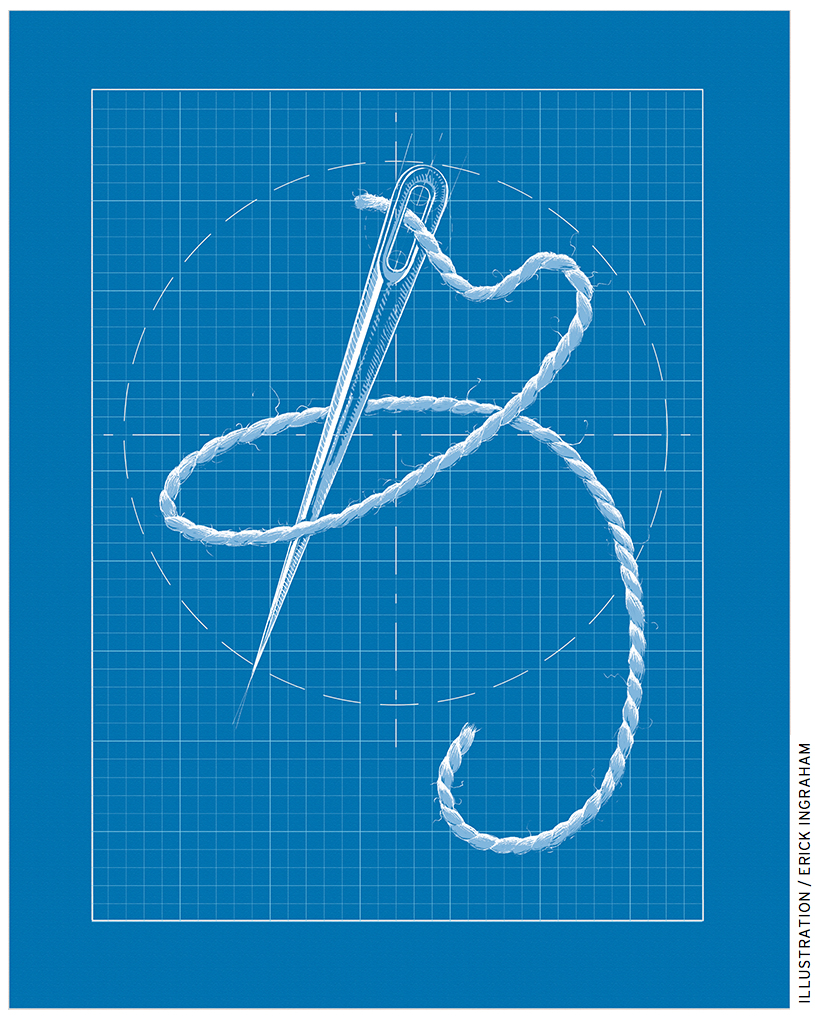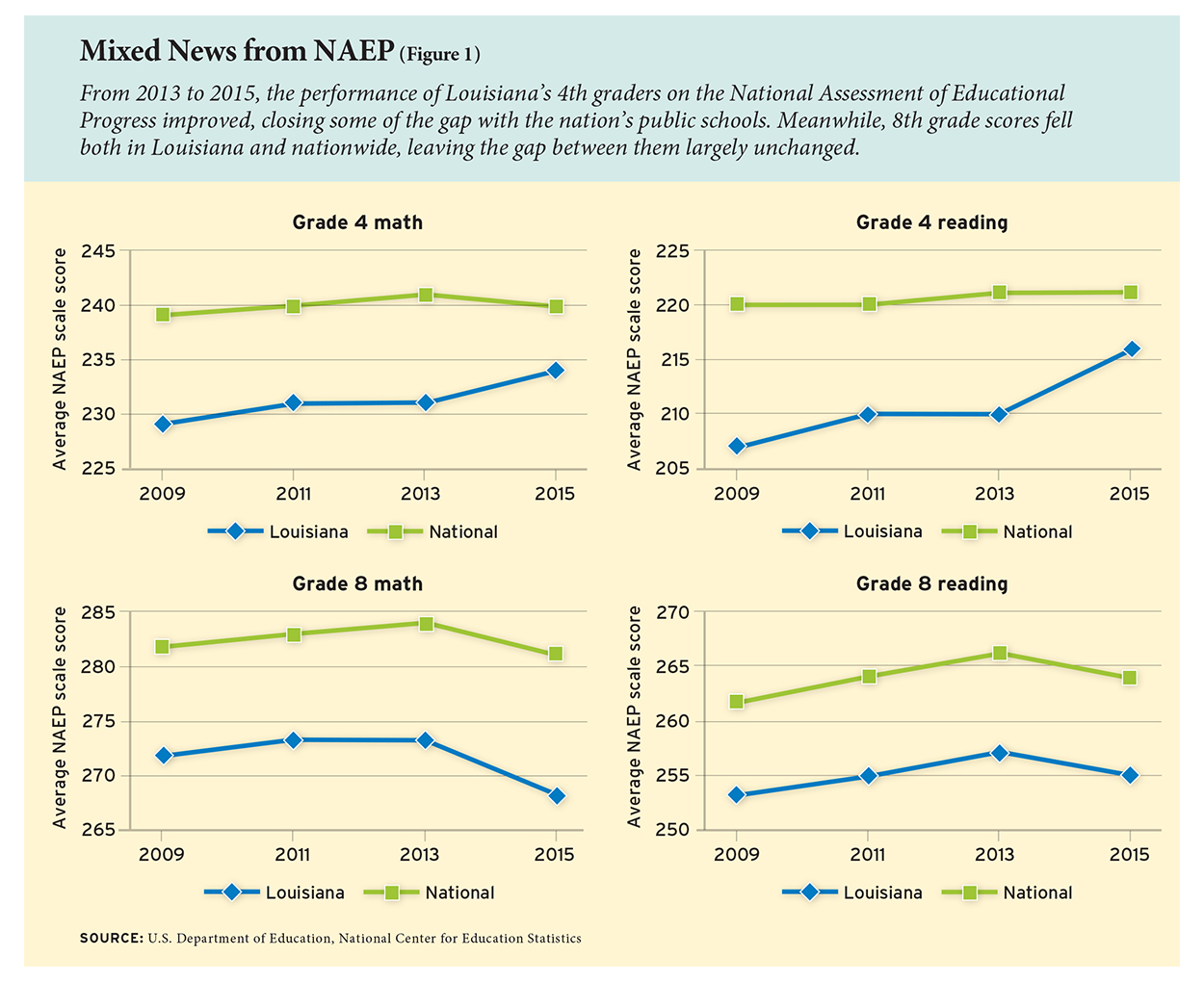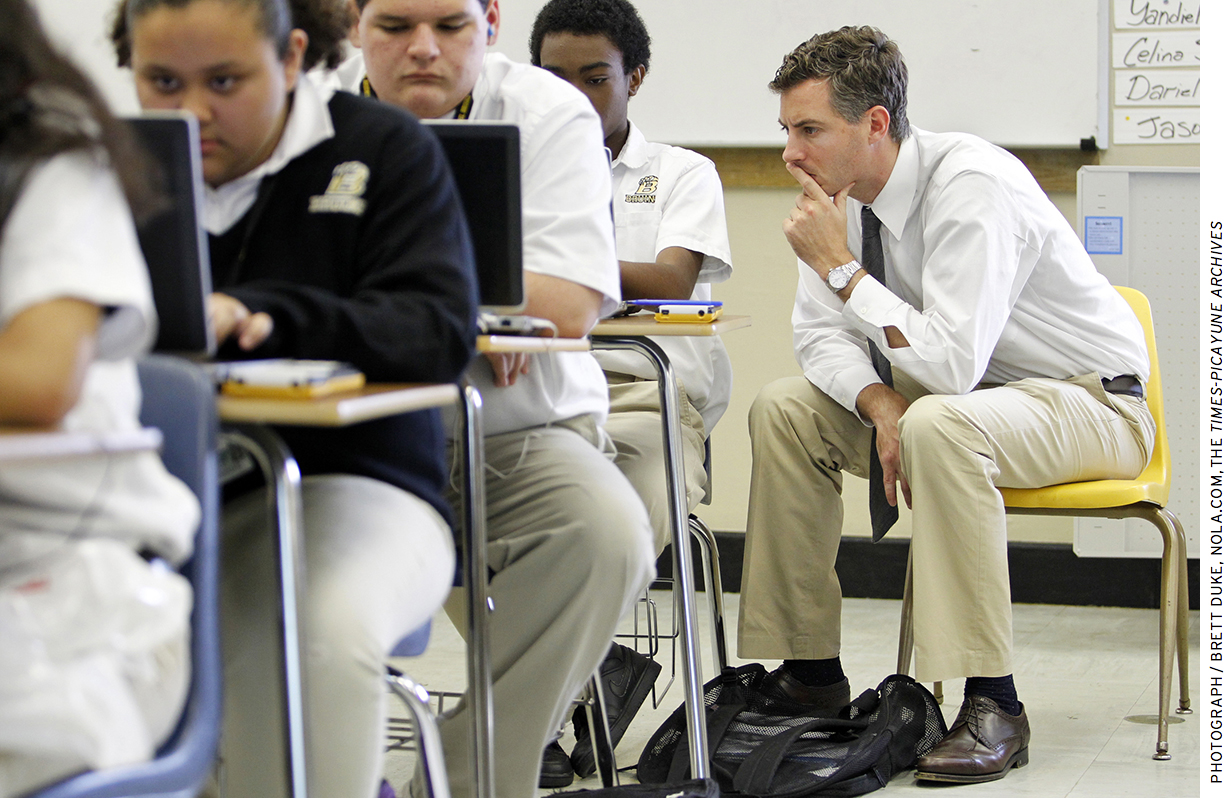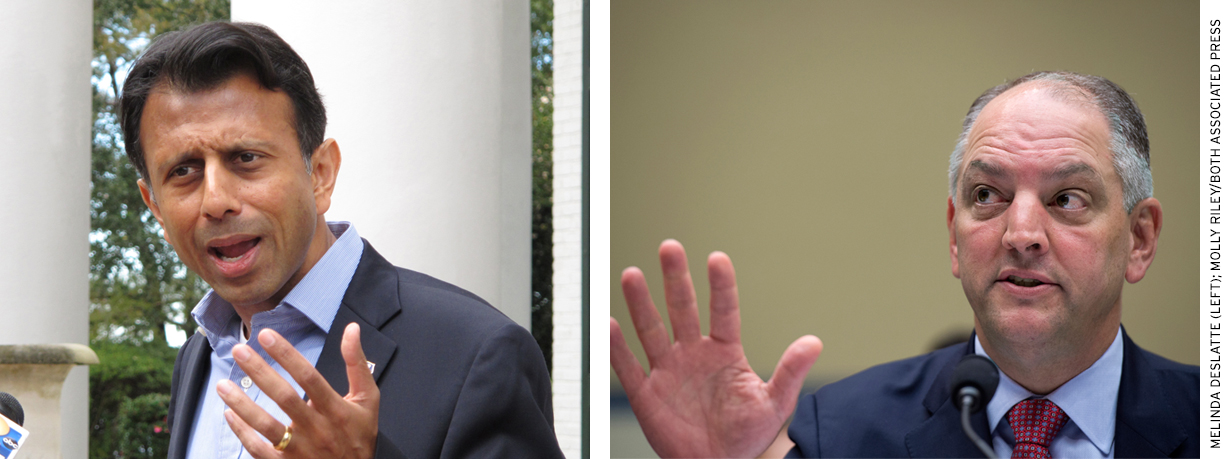“It was one of the most powerful visits I’ve ever taken,” says Sheila Briggs, an assistant state superintendent with the Wisconsin Department of Public Instruction. She is describing a visit last fall to Lake Pontchartrain Elementary School, a low-income school in St. John the Baptist Parish, Louisiana, about 30 miles northwest of New Orleans. “The ability to hear what the state education agency was doing and then go into classrooms and see direct evidence was phenomenal,” Briggs gushes. “I’ve never seen anything like it anywhere else.”
 Officials of state education agencies are not known for hyperbole. Maintaining data systems, drafting rules and regulations, and monitoring compliance are not the stuff of breathless raves—especially in Louisiana, whose education system ranks near the bottom nationwide on measures of student achievement and high-school graduation rates. Yet in the last year, education leaders from across the country have beaten a path here to see what they might learn from state education superintendent John White; his assistant superintendent of academics, Rebecca Kockler; and their colleagues. Together, this team has quietly engineered a system of curriculum-driven reforms that have prompted Louisiana’s public school teachers to change the quality of their instruction in measurable and observable ways. These advances are unmatched in other states that, like Louisiana, have adopted Common Core or similar standards.
Officials of state education agencies are not known for hyperbole. Maintaining data systems, drafting rules and regulations, and monitoring compliance are not the stuff of breathless raves—especially in Louisiana, whose education system ranks near the bottom nationwide on measures of student achievement and high-school graduation rates. Yet in the last year, education leaders from across the country have beaten a path here to see what they might learn from state education superintendent John White; his assistant superintendent of academics, Rebecca Kockler; and their colleagues. Together, this team has quietly engineered a system of curriculum-driven reforms that have prompted Louisiana’s public school teachers to change the quality of their instruction in measurable and observable ways. These advances are unmatched in other states that, like Louisiana, have adopted Common Core or similar standards.
The linchpin of the state’s work has been providing incentives for districts and schools statewide to adopt and implement a high-quality and coherent curriculum, particularly in English language arts (ELA) and mathematics, and to use that curriculum as the hook on which everything else hangs: assessment, professional development, and teacher training. Most notably, White and Kockler have pulled off these reforms in the face of strident political resistance to Common Core and without running afoul of districts and teachers in this staunch local-control state. The state has also posted tantalizing gains in student outcomes: Louisiana 4th graders showed the highest growth among all states on the 2015 National Assessment of Educational Progress (NAEP) reading test, and the second-highest in math (see Figure 1). However, in both Louisiana and the nation as a whole, 8th grade scores in reading and math declined slightly that year. It’s too early to call Louisiana the new Massachusetts—2017 NAEP scores could indicate whether the needle is continuing to move in the right direction—but other states are taking notice and may be following Louisiana’s lead.

“Large and Intriguing Differences”
Adopting new standards accomplishes nothing unless it gets teachers to change classroom practice. In 2016, when researchers at the RAND Corporation set out to study Common Core implementation at the state level, they found something unexpected. Using data from the organization’s American Teacher Panel, a standing nationwide sample of about 2,700 teachers, the researchers noticed “large and intriguing differences” between Louisiana teachers and those in other states. Louisiana’s educators were far more likely to be using instructional materials aligned with Common Core standards. They also demonstrated a better understanding of the standards and taught their students in ways the standards were meant to encourage.
“We saw consistently higher results in Louisiana,” says Julia Kaufman, a RAND policy researcher. “There were occasional high points in other states, but we kept seeing this difference between Louisiana [teachers] and other teachers, which is why we decided to write the report. We just thought there was a story there.”
There is a story, and it’s about curriculum—perhaps the last, best, and almost entirely un-pulled education-reform lever. Despite persuasive evidence suggesting that a high-quality curriculum is a more cost-effective means of improving student outcomes than many more-popular ed-reform measures, such as merit pay for teachers or reducing class size, states have largely ignored curriculum reform.
“People underestimate the power of curriculum. It’s like buying a new water heater. It’s not like getting a new kitchen,” says Litsy Witkowski, chief of staff for academic content at the Louisiana Department of Education. “It’s just not sexy.”
“We believe that states have a role in . . . helping teachers deliver constantly improving instruction for students,” says her colleague Kockler. Louisiana’s articles of faith included “a commitment to coherence and quality” and a belief that if curriculum, professional development, and assessment were not tightly connected, “it would confuse and frustrate teachers,” she adds. Louisiana adopted Common Core in 2010. Two years later, when White arrived and hired Kockler, the state launched a quality review of the curriculum and the instructional materials being used by the districts. Only 1 out of 60 programs passed muster, prompting the state to develop its own ELA curriculum. As White recently told Education Week, commercial publishers had been “relentless about an unwillingness to change and a desire for maximizing profits on old materials that [were] not helping students.”
States often recommend or require the use of various textbooks or curricula. The Louisiana Department of Education (LDOE) was determined to do neither. “We’re a local-control state, so we cannot force anyone to do anything,” says Kockler. “Districts are going to do what they believe is best, and we want to help them be positioned to do so.” The key was offering incentives for districts to make good decisions, a process Kockler describes as “making the best choice the easy choice.” Louisiana began publishing free, annotated reviews of K–12 textbooks and curriculum programs in ELA and math, sorting the materials into three “tiers.” If a curriculum was judged to “exemplify quality,” it earned the Tier 1 designation; programs judged to be “approaching quality” were labeled Tier 2; and those seen as “not representing quality” went into Tier 3. Notably, the quality reviews were not conducted by bureaucrats in New Orleans and Baton Rouge, but by the state’s network of “teacher leaders,” two from each school, chosen by the LDOE. “We basically created the Yelp of curriculum,” quips Witkowski.
The tiering process was rigorous, and few programs earned the Tier 1 designation. Eureka Math, Zearn Math (grades 1–5), and a pair of products from the Math Learning Center made the cut for elementary-school math. In ELA, the Core Knowledge Language Arts program in grades K–3 and the Great Minds Wit & Wisdom curriculum in grades 3–5 and 6–8, among other programs, received the Tier 1 label. The list of Tier 2 curricula is longer, and Tier 3 is longer still. The results of Louisiana’s tiering process are broadly in line with reviews conducted by independent evaluators, such as the nonprofit edreports.org, whose analyses are evidence-based.
The LDOE emphasizes that each of the state’s 131 local school districts should determine if a given curriculum is “appropriate to meet the educational needs of their students.” However, the state sweetened the adoption pot by giving all Tier 1 vendors statewide contracts. Typically, this enabled districts to use these vendors at discounted prices and without having to undergo their own procurement process. “There are a lot of barriers in the system that make it hard for districts and teachers to get their hands on the best stuff,” Kockler observes. “We want the best to be the easiest to access.”
Persuading districts to adopt a top-notch curriculum was just the beginning. “If teachers do not deeply understand their standards—or the instructional practices that are aligned with them—their instruction may fall short of helping students meet those standards,” observes the RAND Corporation’s Kaufman, who, along with Lindsey Thompson and V. Darleen Opfer, found that Louisiana teachers demonstrated a stronger grasp of the Common Core standards and adopted more classroom practices that reflect them than did teachers elsewhere. The trio found that higher percentages of Louisiana ELA teachers were able to correctly identify practices and approaches aligned with Common Core than educators in other states that have adopted the Common Core or similar standards. For example, less than half (47 percent) of Louisiana teachers thought that “selecting texts for individual students based on their reading levels” was an instructional approach aligned with standards (it’s not) compared to 70 percent of teachers in other states. Most teachers in Louisiana perceive—correctly—that their standards instead encourage them to teach particular grade-level texts and organize reading skills instruction around those texts rather than teaching reading skills and allowing students to apply them to any text. This approach represents a watershed instructional change that is still unusual—except in Louisiana.
The teachers didn’t acquire their instructional savvy by accident. State officials, having identified a small number of Tier 1 curricula, applied a similar winnowing process to professional-development providers, recommending only vendors such as Achievement Network (ANet), American Reading Company, Generation Ready, LearnZillion, and others that could offer training geared specifically to Louisiana’s Tier 1 curricula instead of general pedagogical strategies or techniques. This too is an unusual practice. Most states provide professional development, but the RAND researchers did not find other clear examples of state departments of education working to make explicit connections between professional-development providers and specific curricula.
The combined power of persuasion, purse, and professional development has reaped results: nearly 90 percent of teachers in Louisiana who responded to the RAND survey report using Eureka Math, a Tier 1 program.
Significantly, all of this work was done with teachers, not to them. The LDOE created a network of teacher leaders who were handpicked for demonstrated teaching and leadership ability, drawn from every region of the state and different grade levels. While the state created the rubrics for the curriculum, it was the teachers who did the evaluations—a feature that draws praise from the state’s largest teachers union.
“We had lots of buy-in,” says Larry Carter, president of the Louisiana Federation of Teachers. “There’s some sense of stability to how education is being delivered to students.”
This teacher-friendly approach to reform has also altered the relationship between the Louisiana DOE and school districts. Previously, LDOE visits were “very compliance-driven,” says Dana Talley, a veteran teacher and state network leader in northeast Louisiana. “Now it feels like support, not compliance,” she adds.
Carter agrees with Talley’s take. Although the union doesn’t “see eye to eye with the superintendent on testing,” they generally agree on “issues that relate to curriculum and standards.”
Joanne Weiss, the former chief of staff at the U.S. Department of Education under Secretary Arne Duncan, has brought education officials from more than a dozen states to Louisiana in her capacity as a consultant to the Council of Chief State School Officers (CCSSO). Weiss gives White and Kockler high marks for their clear-eyed view of their state’s education system. “I think people have a tendency to develop strategies that are completely absent the context of the moment in time or the place. Rebecca and John are doing the opposite,” she observes. “They’re saying, ‘Our work needs to sit at the nexus of good content, good professional learning for teachers, and good measurement tools and assessments. We need to get those three things right.’”

Curriculum in Action
On a Monday morning in January, Yasmin Haley, a 6th grader at Lake Pontchartrain Elementary School, is working with two other girls on changing the point of view in a story from third-person-limited to first person. The girls are studying a picture of two characters named Gerry and Perry who, according to a brief narrative written by another group of students, have been fighting. “It has to be the same concept, but a different perspective,” Haley tells me, explaining the assignment. She turns to her two classmates: “It might say what Gerry’s thinking,” she says. “We have to use the voice of the person.” Across the room, their teacher, Michel Delatte, circulates among the students. At one point she calls out to the class, “Be mindful of your grammar!”
Louisiana created “Guidebooks 2.0,” a homegrown language-arts curriculum, in response to lackluster reviews its teachers gave to commercial programs. It features lengthy units on the novels Hatchet, The Witch of Blackbird Pond, and Out of the Dust; and a nonfiction unit on Apple founder Steve Jobs. It is the primary ELA curriculum resource for grades 6–8 at Lake Pontchartrain, a Title I school where 100 percent of the students are eligible for free or reduced-price lunch. But this lesson was created by Delatte herself. “I supplement the state guidebooks because I know point of view is on the test,” she tells me. “A lot of times they ask [students] to change the point of view of a story. So this is a great way for them to do that. They like working in groups, and it’s fun for them to get out of their seats, move around, see what others wrote, and improve their own writing.”
In the next classroom I visit, accompanied by principal Jason Beber, 4th graders are working on a reading comprehension exercise on geology, part of “The Changing Earth” unit of the Core Knowledge Language Arts program, which the district has adopted in grades K–5. Lake Pontchartrain Elementary was badly damaged by 2012’s Hurricane Isaac; now, most of the classes meet in temporary trailers while construction of a new building gets underway nearby. In the next trailer, another 4th-grade teacher, Jennifer Brock, leads an equivalent-fractions lesson from Eureka Math, which St. John uses end to end, from K to 12. “Teachers have a clear picture of what they’re supposed to be doing in the classroom,” says Beber, who is in his third year running the school, which has gone from a D to a C on state-issued school performance reports, despite the disruption wrought by the storm.
“Soon to be a B,” he cheerfully insists as we move on to the next classroom. In nearly every room hangs an identical poster, a knockoff of the iconic World War II–era poster aimed at reassuring an anxious British public: “Keep Calm and Score Basic or Above.”
The decision to go with Core Knowledge, the state’s Guidebooks, and Eureka Math were district-level calls, and Beber sees no reason to second-guess the decision. At the school level, curriculum is not negotiable, he says. “This is our religion. This is what we do. But we need great teaching to deliver it and to make it happen for everybody.” As we saw in Delatte’s room, teachers have the freedom to supplement the curriculum to meet the needs of their students or to respond to the demands of state tests.
Policy and Politics
“American policymakers seldom view curriculum as a serious lever for change,” observes Ashley Berner, deputy director of the Institute for Education Policy at Johns Hopkins School of Education. Requiring children to learn anything in particular, she notes, is considered “pedagogically suspect.” Pitched and passionate battles over course content have made curriculum a third rail in many states. But the failure of states to exert influence or offer expertise on curriculum leaves these decisions to districts, schools, and even individual teachers, which risks robbing students of coherence and consistency. Local control is a central feature of American public education, but Louisiana’s reforms offer a glimpse of how to thread the needle, honoring community control while encouraging high-quality curriculum statewide.
“You can’t just tinker around the edges with high-level things,” says Kim Benton, chief academic officer (CAO) in Mississippi’s Department of Education. “You’ve got to reach deeper into the classroom to really make sure instructional quality is improving.” Benton was one of more than a dozen state CAOs who visited Louisiana with Joanne Weiss last fall, a trip funded by the Council of Chief State School Officers. CCSSO is developing a network of states interested in supporting their schools in identifying and adopting high-quality curricula aligned to standards.
It’s no secret that curriculum choices can be a significant factor in raising academic success, as Massachusetts has demonstrated for nearly 25 years. The state’s landmark 1993 Education Reform Act introduced not only high academic standards, accountability, and enhanced school choice, but curriculum frameworks with a subject-by-subject outline of the material intended to form the basis of local curricula statewide. Massachusetts has led the nation in student achievement ever since. And a small but rigorous body of evidence confirms that curricular choices matter. A 2009 federal study of four elementary school math curricula, for example, found that students in schools assigned to use the most effective program performed 12 percentile ranks higher after one year than students in schools assigned to the least effective program.
However, districts may find it challenging to choose textbooks and instructional programs based on demonstrated efficacy, because the research base on specific programs remains thin. A March 2017 paper by David Steiner, director of the Johns Hopkins Institute for Education Policy, notes that while changing curriculum is mainly “cost-neutral” (teachers are going to teach something and there’s little price difference between good and bad textbooks), we still don’t know exactly what makes a curriculum effective. This gap exasperates Steiner, himself the former state education commissioner of New York, where he championed the creation of the EngageNY curriculum website with funding from the state’s $700 million Race to the Top grant.
“What we teach isn’t some sidebar issue in American education. It is American education,” Steiner observes. “The track record of top-performing countries, early evidence of positive effects from faithful implementation of high-quality curricula here in the United States, and the persistent evidence that our classrooms are under-challenging our students at every level compel us to put materials that we use to teach at the core of serious education reform.”
Louisiana offers a kind of proving ground for Steiner’s view. The open question is how much of Louisiana’s apparent gains can be attributed to standards, curriculum, and talent development driven by changes at the state level—and how many other states will follow the path White and Kockler have blazed. The states that do so, Weiss cautions, “need to understand their [own] particular strengths and deficits, and work from that reality. What Louisiana has done may not export exactly as is, but there are still a lot of lessons to learn.”
Weiss is working with the CCSSO on a two-year effort to encourage states to adopt a standards-aligned, high-quality curriculum, to support them in its implementation, and to ensure that teachers have access to relevant professional development. CCSSO executive director Chris Minnich admires Louisiana’s model but stresses that one key to its success was the state’s diplomatic approach. “The brilliance of what happened in Louisiana is they didn’t make a single choice for any school district in the state. They simply provided good information, training, and incentives.” While not every state will choose to follow Louisiana’s lead, “we want as many willing and able states to go there as possible,” he says, adding that not all states have the structures in place to fully support local school districts in making better curriculum choices.
And the operative word is “support.” “States thought they only had one tool in their toolbox, which was to mandate curriculum or leave it entirely up to local districts,” Minnich notes. “Bottom line is, they shouldn’t be making these decisions for their districts. There’s no buy-in that way.”
A small number of states will be selected to participate in the two-year CCSSO project, funded by the Charles and Lynn Schusterman Family Foundation and the Bill & Melinda Gates Foundation. CCSSO’s effort aims to “significantly increase” the percentage of school districts in targeted states in which curriculum and materials adoptions are of high quality and aligned to state standards; and to increase the percentage of professional-development and teacher-prep programs that include training on those curricula. In sum, it seems quite possible that the moment is at hand for curriculum and instructional material to be taken seriously as a reform lever.

Making It Stick
State education leadership can flip as often as baseball managers change their lineups. Or their socks. This instability only compounds the difficulty of making reforms stick. Now in his sixth year on the job, John White is one of the longest-serving state supes—a job where the average tenure is less than two and a half years. He has proven to be a skilled political infighter, surviving bruising battles with the state’s two teachers unions, Tea Party members, and Common Core opponents. He crossed swords with Bobby Jindal, the governor who supported his appointment, over Common Core. Once an avid supporter, Jindal turned against the standards prior to his failed bid for the White House. Jindal’s successor, John Bel Edwards, announced during his campaign for governor, “I have no intention of allowing John White, who isn’t qualified to be a middle school principal, to remain as superintendent.” White’s still there. Louisiana’s curriculum-based reforms may well outlast even him, though he has said he hopes to continue to serve “until BESE [Louisiana’s Board of Elementary and Secondary Education] tells me to stop.” Once districts have affordable, sustainable, and successful practices in place, they are “less apt to remove them and replace them than they were to add them in the first place,” he says. It’s true that a single school-board member with an agenda or strong political views can jeopardize an entire curriculum, but the teacher-leader network that White and Kockler have constructed in Louisiana seems likely to insulate students from the passions and politics of the moment. If teachers’ response to uncertainty is to close their doors and teach what they know, most of what they now know is Louisiana’s set of Tier 1 curricula, which has grown to encompass materials for early childhood, social studies, and science programs, along with math and ELA interim and benchmark assessment systems.
For now at least, Louisiana remains a laboratory from which other states can learn as they evaluate their own efforts to make more rigorous standards stick.
“There was definitely a higher level of instruction going on in the Louisiana classrooms we visited as compared with what many other states’ CAOs were seeing at home. That was very compelling to people,” notes Weiss. Some of them, she adds, “resolved to go home and make curriculum reform a priority in their own states, saying, ‘We need to do this. This is really important, and we need to do this.’”
Robert Pondiscio is a senior fellow at the Thomas B. Fordham Institute.
This article appeared in the Fall 2017 issue of Education Next. Suggested citation format:
Pondiscio, R. (2017). Louisiana Threads the Needle on Ed Reform: Launching a coherent curriculum in a local-control state. Education Next, 17(4), 8-15.


